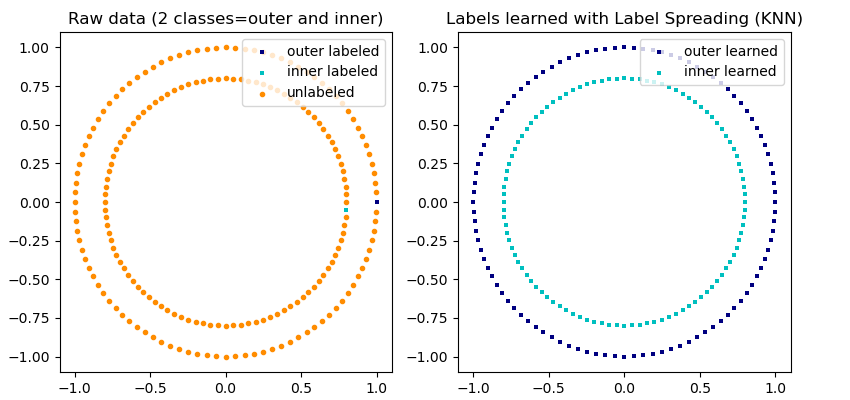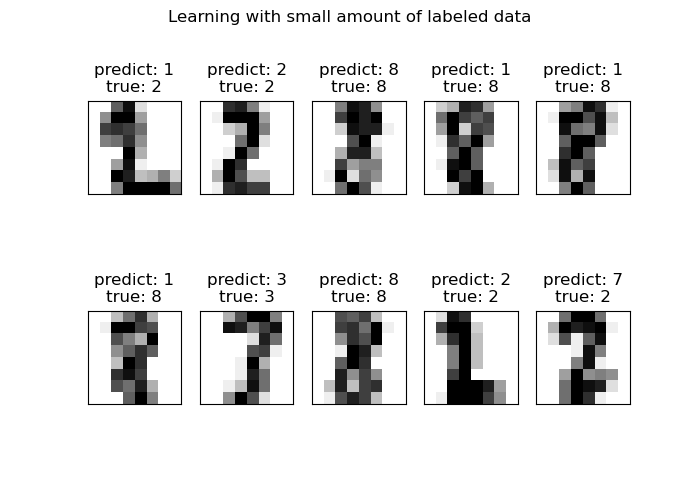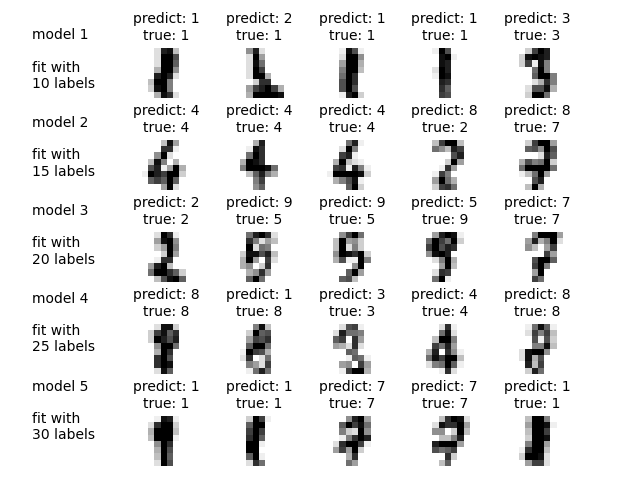sklearn.semi_supervised.LabelSpreading?
class sklearn.semi_supervised.LabelSpreading(kernel='rbf', *, gamma=20, n_neighbors=7, alpha=0.2, max_iter=30, tol=0.001, n_jobs=None)
用于半監督學習的LabelSpreading模型
該模型類似于基本的標簽傳播算法,但是使用基于歸一化圖拉普拉斯算子和跨標簽的軟夾持的關聯矩陣。
在用戶指南中閱讀更多內容。
| 參數 | 說明 |
|---|---|
| kernel | {‘knn’, ‘rbf’} or callable, default=’rbf’ 要使用的內核函數或內核函數本身的字符串標識符。只有'rbf'和'knn'字符串是有效輸入。傳遞的函數應采用兩個輸入,每個輸入的形狀為(n_samples,n_features),并返回一個(n_samples,n_samples)形狀的權重矩陣。 |
| gamma | float, default=20 rbf內核的參數。 |
| n_neighbors | int, default=7 knn內核的參數,它是嚴格的正整數。 |
| alpha | float, default=0.2 軟夾持系數。(0,1)中的一個值,指定一個實例從它的鄰居(而不是它的初始標簽)接收的信息的相對數量。alpha = 0表示保留初始標簽信息;alpha = 1表示替換所有初始信息。 |
| max_iter | int, default=1000 允許的最大迭代次數。 |
| tol | float, 1e-3 收斂容差:認為系統處于穩定狀態的閾值。 |
| n_jobs | int, default=None 要運行的核心數。 除非在上下文中設置了 joblib.parallel_backend,否則None表示1 。 -1表示使用所有處理器。有關更多詳細信息,請參見詞匯表。 |
| 屬性 | 說明 |
|---|---|
| X_ | ndarray of shape (n_samples, n_features) 輸入數組。 |
| classes_ | ndarray of shape (n_classes,) 用于分類的不同類別標簽。 |
| label_distributions_ | ndarray of shape (n_samples, n_classes) 每個項目的分類分布。 |
| transduction_ | ndarray of shape (n_samples) 通過轉換分配給每個項目的標簽。 |
| n_iter_ | int 運行的迭代次數。 |
另見
基于非正規圖的半監督學習
參考
Dengyong Zhou, Olivier Bousquet, Thomas Navin Lal, Jason Weston, Bernhard Schoelkopf. Learning with local and global consistency (2004) http://citeseer.ist.psu.edu/viewdoc/summary?doi=10.1.1.115.3219
示例
>>> import numpy as np
>>> from sklearn import datasets
>>> from sklearn.semi_supervised import LabelSpreading
>>> label_prop_model = LabelSpreading()
>>> iris = datasets.load_iris()
>>> rng = np.random.RandomState(42)
>>> random_unlabeled_points = rng.rand(len(iris.target)) < 0.3
>>> labels = np.copy(iris.target)
>>> labels[random_unlabeled_points] = -1
>>> label_prop_model.fit(iris.data, labels)
LabelSpreading(...)
方法
| 方法 | 說明 |
|---|---|
fit(X, y) |
擬合基于半監督的標簽傳播模型。 |
get_params([deep]) |
獲取此估計器的參數。 |
predict(X) |
在模型上執行歸納推理。 |
predict_proba(X) |
預測每種可能結果的概率。 |
score(X, y[, sample_weight]) |
返回給定測試數據和標簽上的平均準確度。 |
set_params(**params) |
設置此估計器的參數。 |
__init__(kernel='rbf', *, gamma=20, n_neighbors=7, alpha=0.2, max_iter=30, tol=0.001, n_jobs=None)
初始化self。請參閱help(type(self))獲取更準確的信息。
fit(X, y)
擬合基于半監督的標簽傳播模型。
提供所有輸入數據的矩陣X(標記和未標記)和對應的標記矩陣y,對未標記樣本有一個專用的標記值。
| 參數 | 說明 |
|---|---|
| X | array-like of shape (n_samples, n_features) 形狀為(n_samples,n_samples)的矩陣。 |
| y | array-like of shape (n_samples,)n_labeled_samples(未標記的點被標記為-1)所有未標記的樣本將被轉換指定的標簽。 |
| 返回值 | 說明 |
|---|---|
| self | object |
get_params(deep=True)
獲取此估計量的參數。
| 參數 | 說明 |
|---|---|
| deep | bool, default=True 如果為True,則將返回此估算器和所包含子對象的參數。 |
| 返回值 | 說明 |
|---|---|
| params | mapping of string to any 參數名稱映射到其值。 |
predict(X )
在模型上執行歸納推理。
| 參數 | 說明 |
|---|---|
| X | array-like of shape (n_samples, n_features) 數據矩陣。 |
| 返回值 | 說明 |
|---|---|
| y | ndarray of shape (n_samples,) 輸入數據的預測值。 |
predict_proba(X )
預測每種可能類別的概率。
計算X中每個樣本的概率估計值,以及訓練過程中看到的每個可能結果(分類分布)。
| 參數 | 說明 |
|---|---|
| X | array-like of shape (n_samples, n_features) 數據矩陣。 |
| 參數 | 說明 |
|---|---|
| probabilities | ndarray of shape (n_samples, n_classes) 跨類標簽的歸一化概率分布。 |
score(X,y,sample_weight = None )
返回給定測試數據和標簽上的平均準確度。
在多標簽分類中,這是子集準確性,這是一個苛刻的指標,因為需要為每個樣本正確預測對應的標簽集。
| 參數 | 說明 |
|---|---|
| X | array-like of shape (n_samples, n_features) 測試樣本。 |
| y | array-like of shape (n_samples,) or (n_samples, n_outputs) X的真實標簽。 |
| sample_weight | array-like of shape (n_samples,), default=None 樣本權重。 |
| 返回值 | 說明 |
|---|---|
| score | float 真實值與測試值的平均準確度。 |
set_params(**params)
設置此估算器的參數。
該方法適用于簡單的估計器以及嵌套對象(例如管道)。后者具有<component>__<parameter>形式的參數, 以便可以更新嵌套對象的每個組件。
| 參數 | 說明 |
|---|---|
| **params | dict 估計器參數。 |
| 返回值 | 說明 |
|---|---|
| self | object 估計器實例。 |




